Environmental Engineering Reference
In-Depth Information
Cumulative heave, mm
0
40
80
120
0
After 25
th
step
(last step)
After
5
th
step
2.6
mm
0.5
117 mm
115 mm
10
th
15
th
20
th
1.0
PDE solver
Fredlund et al., (1980)
1.5
2.0
Figure 14.63
Calculation of total heave as stress steps are taken from initial in situ stress state
to condition of zero suction in soil.
14.9 TWO-DIMENSIONAL SOLUTION USING
INCREMENTAL ELASTICITY FORMULATION
14.10 CHALLENGES IN NUMERICALLY
MODELING OF EXPANSIVE SOIL PROBLEMS
The total stress fields in a soil continuum can be solved
using Eqs. 14.48 and 14.49. Consideration will only be
given to changes in total stresses through a two-dimensional
continuum space. The pore-water pressure and the pore-air
pressure are assumed to remain unchanged as a total stress
loading is applied at the ground surface. In other words,
there is a decoupling of the pore fluid effects from the appli-
cation of a total stress at ground surface. The coupling of
total stresses and pore fluid pressure changes is considered
in Chapter 16.
One example problem is solved to illustrate that the inde-
pendent calculation of total stress field in unsaturated soils
is similar to the calculation of total stress fields for a dry
soil mass.
There are a number of challenges that have arisen with
respect to the numerical modeling of expansive soil behav-
ior. For example, there has not emerged a single constitutive
equation to adequately describe the entire void ratio consti-
tutive surface of an unsaturated, expansive soil. The soil
properties are generally measured in terms of compressibil-
ity values from laboratory oedometer tests. The laboratory
results yield a compressibility (or swelling) index as a single
soil property. In order to use the results in a multidimen-
sional stress-deformation analysis, it is necessary to estimate
a Poisson's ratio value while a Young's modulus value is
converted from the oedometer test results. In other words,
one soil property is measured; however, two soil properties
are required in order to perform the analysis. The incremen-
tal linear elastic approach also has its limitations.
Another significant challenge occurs when attempting to
model conditions where the matric suction goes to zero
under low net normal stress conditions. When an expansive
soil exists at ground surface, the net normal stress goes to
zero if there is no applied load. If at the same time the matric
suction goes to zero, there can be difficulties in calculating
the total heave. These issues are related to the lack of defini-
tion of the constitutive surface under low-stress conditions.
The need to combine the stress-deformation analysis with a
saturated-unsaturated seepage analysis is further discussed
in Chapter 16.
14.9.1 Example Problem Involving Comparison with
Bousinesq Stress Analysis
The load applied by a long strip footing is used to illustrate
the calculation of total stress fields in an unsaturated soil
mass (Fig. 14.64). Total stresses are calculated using a finite
element numerical model (SV Solid). A constant Young's
modulus
E
of 10,000 kPa is assumed along with a Pois-
son's ratio of 0.33. The applied ground surface pressure is
1000 kPa applied over a 1-m-wide surface. The intent is to
examine the calculated stresses and therefore no attention is
paid to the computed displacements.
Figure 14.64 presents the stress influence values below
a strip footing obtained from a closed-form solution when
using the Bousinesq theory. Also shown are the influence
factors computed from the solution of Eqs. 14.58 and 14.59.
The finite element method was used to solve the partial dif-
ferential equations for the two-dimensional stress analysis.
The results indicate close agreement between the total stress
states computed by the two methods.
14.10.1 Equations for Void Ratio Constitutive
Relationship
Several equations have been proposed to define the
constitutive soil properties with respect to changes in the
stress state of a soil. These equations are capable of repre-
senting the soil properties for specific stress state changes.
The equations are determined for a particular soil under




























Search WWH ::

Custom Search